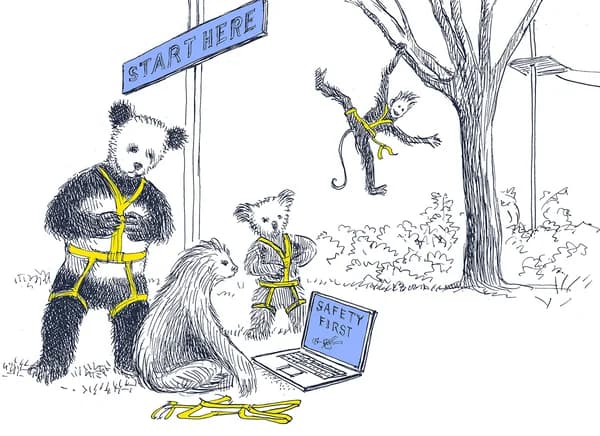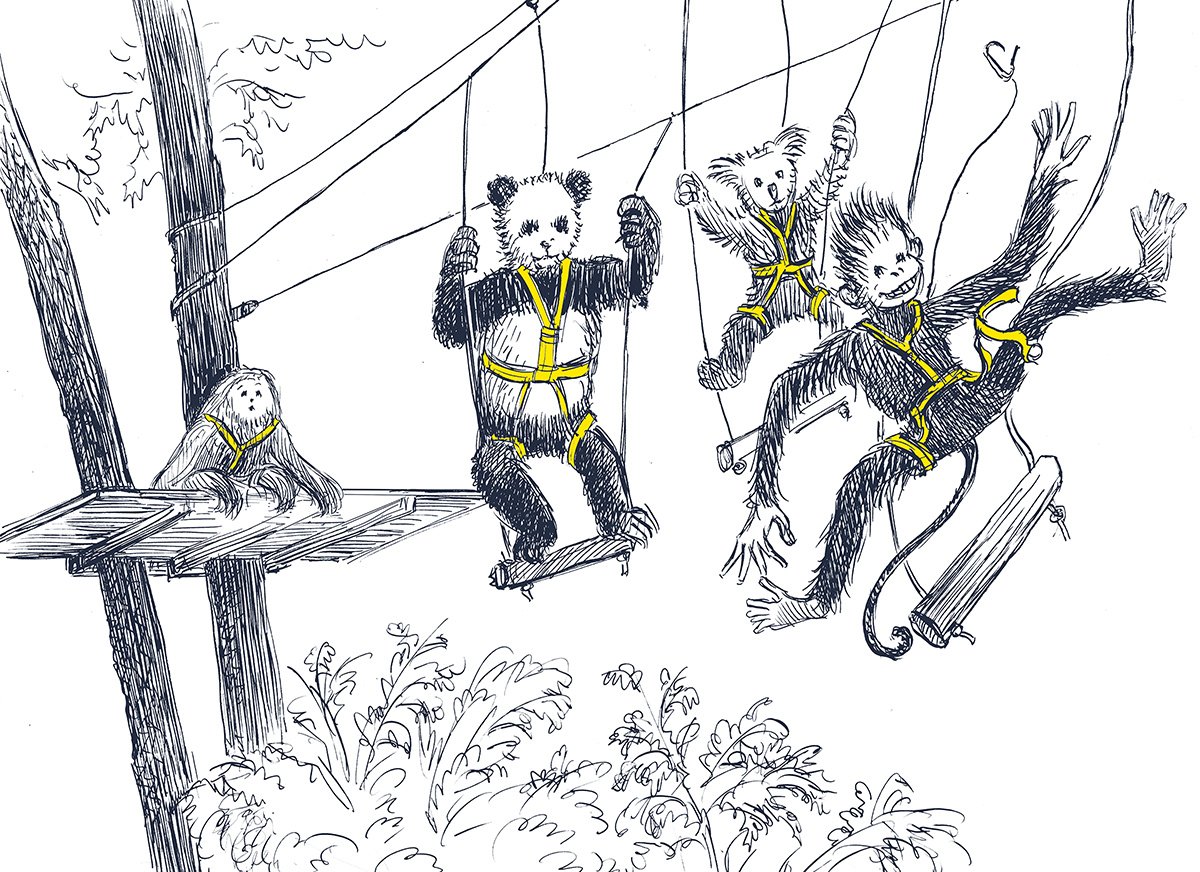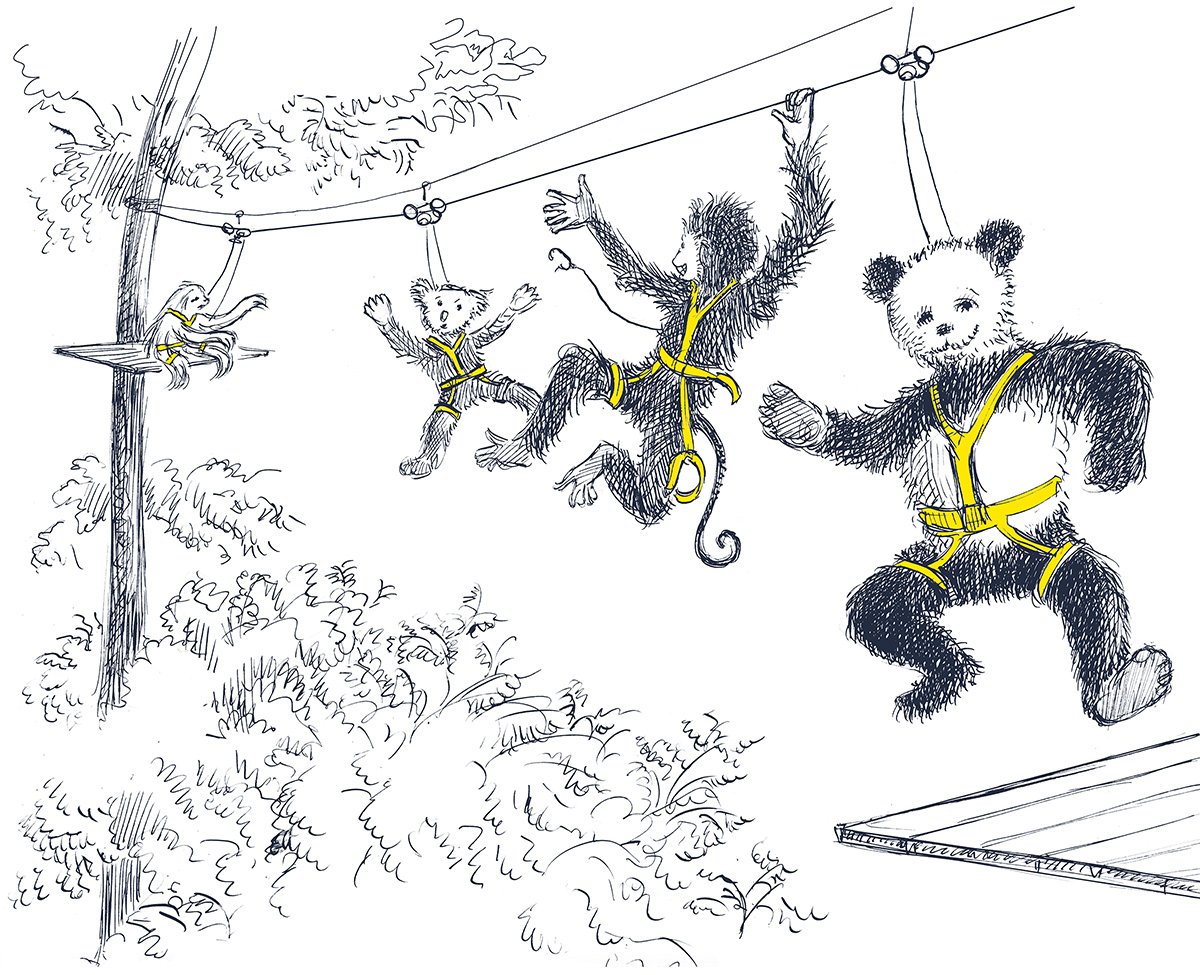If you meet Buddha on the road, kill him.
Normally killing isn’t associated with Buddhism, but this is what you think standing on a platform 30 feet above the ground, with nothing between you and certain death except the trust of a cable and a few locking carabiners.
Outside of a few guidelines from a low-budget safety video, the beauty of a ropes course is that you are challenged to rethink your assumptions about getting from point A to B. A ropes course is a framework connecting endpoints. There is no right or wrong, no instruction beyond the necessary safety of staying clipped into the course.
There is no guru, no teacher, no expert. No step-by-step instruction.
How often do you seek out “the answer” from experts? The idea behind seeking an expert is to learn from them. Buddha’s search for enlightenment was his path, but that doesn’t necessarily mean what worked on that path will work for you.
Experts only know one path — how they did it. This strategy, formula, recipe, etc., gives you step-by-step instructions on how to get from point A to point B in your business. Sounds great, until your business doesn’t fit the recipe. If your business is unique — and it is — then why are you seeking a generic solution?
We prefer frameworks — business ropes courses — that include the proper safety equipment but are also open to embracing the uniqueness of your business. A scientific approach instead of a step-by-step recipe.
Buddha has left the building.

Prophets vs. Profits
Experts give you formulas. Do this, use that, get this expected result. Like a Ronco kitchen commercial, just set it and forget it, and voila! Like magic, success.
Frameworks start with identifying the problem to be solved and asking questions. Instead of prophesying from assumptions, frameworks unthink assumptions around a situation.
The right equipment
A harness is essential to exploring a ropes course. The first lesson for anyone is the basics of putting on a harness correctly so that the rest of the safety equipment can do its job, namely, keeping you locked into the course and not falling from it.
An ill-fitting harness can spell disaster. If you jump straight to the course without wearing the right size harness or tightening the strap points correctly, trouble lies ahead. The best-case scenario is losing time on the course because you had to switch out harnesses to the right size; the worst-case scenario could be injury or worse. The team of people at the course checkpoints ensure you have the right equipment. They ask you to tighten your straps, show your harness clips are secure and that you have the right locking carabiners before starting the course. They document the safety checks and equipment.
If the team isn’t asking questions and creating documentation, they may wrongly assume you have the right equipment.
Consider a real-life example where asking the questions is important. You have a custom T-shirt store. Customers bring in their designs and you print them on shirts. Your team is implementing new software at your company that allows you to sell your custom shirts online. However, this new platform has to tie into your existing store systems — design, production, inventory, order processing, shipping, and database management, to name a few. Like most software projects, the different systems do not natively integrate. Your team has to solve the challenges and create a customized solution for your business.
The prophets start to immediately look for solutions in this scenario. Armed with assumptions, they jump to pitching solutions such as off-the-shelf software or third-party vendors, hiring people to process the data instead.
In a framework, you start by asking questions: What are we trying to accomplish? What are the requirements? What are our existing resources? What have we tried? What were the past results? Who should be involved? What data do we have? These questions guide an open discovery that defines the course of action and creates a documented single source of truth, aligning the entire team. Frameworks bring transparency into situations and prevent false assumptions, ensuring you have the right equipment from the start.
Safety in a Framework
The next lesson of a ropes course involves a tweezle. The tweezle is a key that allows you to lock and unlock a carabiner that connects your safety harness to a cable. The locking and unlocking of the carabiners allow you to explore a course and zip line without fear of death from a terrible fall.
Safety is built into your business framework. If you have done the due diligence of asking the right questions, risks are identified and managed from the start. Your carabiner is locked in the course, your company isn’t going to go down with the project.
Safety in a framework takes many forms. If the risk is financial, then the safety could be timely reporting through a profit and loss statement. If the risk is operational, then the safety could be creating a test environment or safe space that doesn’t impact your live operations. If the risk is HR-related, then the safety could be open communication, smaller team testing, or measurable clear expectations. For every risk, you can build a tweezle that allows you to lock into your framework course.

Strategies vs. Frameworks
No one enjoys being wrong. Right?
Ask Danny Kahneman, the Nobel-prize-winning psychologist and he will tell you that it is wonderful to be wrong. For Danny it is simple, discovering that he is wrong about something means now, with this new information, he is less wrong in the present than he was in the past. Danny approaches life like a scientist. He claims, “My attachment to my ideas is provisional. There is no unconditional love for them.”
Attachment explains why humans act the way they do even when reason tells us otherwise. We have all done things that are unexplainable when a strong belief is involved. Faith, love, politics, and self-identity are all examples where attachment short-circuits even the most logical arguments. In Adam Grant’s book, “Think Again”, he explores this very human conundrum. He argues that “most of us are accustomed to defining ourselves in terms of our beliefs, ideas, and ideologies. This can become a problem when it prevents us from changing our minds as the world changes and knowledge evolves. Our opinions become so sacred that we grow hostile to the mere thought of being wrong.”
All of us are guilty of inflicting our attachments when solving problems. Rethinking assumptions doesn’t come naturally. The statement “because we have always done it this way” kills more profit and transformation than company errors. A mere 30% of re-engineering projects succeed because of resistance caused by attachment.
By their nature, strategies are attachments. Defined as a plan of action or policy designed to achieve a major or overall aim, strategies define the steps and the path. Strategies belong within frameworks.
Once you start the ropes course, you consider how to navigate each obstacle. You consider different strategies. However, if you start with a set assumption, only one strategy, you may find it harder than it would have been if you had been more open to different techniques.
Maybe you don’t even get started. If you are attached to the idea that you will fall, despite all the safety equipment preventing that scenario, no logic will convince you otherwise. The only way forward on the course is to rethink your assumption that you will fall.

Gurus vs. Guides
Ziplines can be tricky to navigate on a ropes course. Unlike other obstacles that require measured agility and balance, ziplines are about letting the equipment do most of the work guiding you to the next platform with ease. If you let it. Hold on too tightly and you will make it harder for the equipment to ferry you across. There is a good chance you might just lose all momentum and find yourself stopping short of the next platform.
Everyone finds their technique on a zipline. You can kick off for speed from the starting platform, you can hold on to the harness or clips, or let your arms go free. Some choose to land feet first, while others find a hands-first approach more to their liking. The point is that there is no right or wrong way to zipline — the equipment is your guide across.
Most gurus are not bad people. What some of them have forgotten, and their audiences misunderstand, is that a true guru is merely sharing how they found “their way,” not “the way.” However, the steps along the path they share are their unique journey, not necessarily a blueprint of what will work for any individual.
Guides help us ask better questions. They share their formulas and strategies, yes, but within a framework. Gurus start with step-by-step formulas outside a framework.
In life and business, you need a guide, not a guru. A framework, not a formula.


